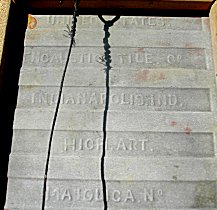Sunday, September 17, 2006
Indiana Art Tiles
I must blame the vicissitudes of advancing years, involving members of my immediate family and even your humble blogger, for a hectic year that barely allowed the occasional political blog post much less anything connected to cooking or pottery.
This Sunday, for some unfathomable but soothing reason, I felt the urge to post exclusive web images of some fairly rare 19th century American Art Tiles.

This honey-glazed and dust-pressed relief tile set of cherubs or putti warming themselves at a campfire was sculpted by Ruth M. Winterbotham and manufactured by the United States Encaustic Tile Company in Indianapolis, Indiana between 1877 and 1886 and is a personal favorite.
While this particular 6” X 12” set appears very occasionally, it is documented in various tile reference books like Norman Karlson’s American Art Tile.
I am aware of a similar set that sold for around $400 in late 2001.

This interesting 6” square relief tile of a pioneer woman, also manufactured in the late 19th century by an Indiana tile company, the Columbia Encaustic Tile Company of Anderson, Indiana, is not only rare but is not pictured in any American Art Tile reference book with which I’m familiar.
I have to imagine this tile would currently sell for over $100.
I bought this tile around 8 or 9 years ago from an unsuspecting Ebay seller for almost $40.

This is an enhanced image of the 1877-1886 mark pressed into the obverse side of the "cherub" tiles shown at the top of this post.
The mark says, "United States Encaustic Tile Co. Indianapolis, Ind. High Art Majolica No."
In 1886, according to Karlson, the company failed and was reorganized as the United States Encaustic Tile Works.
Post 1886 tile marks from the reformed Indiana company would reflect this name change.
Photos: sean

